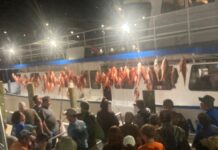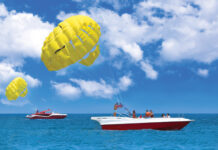By Jamie Zimchek
In the 1960s, America was aiming for the moon and distant, dark depths of space. It wasn’t just the race for space on the horizon though: deep below the ocean surface, another kind of race was taking place, a race for the sea. Forget outer space – this less publicized effort, led by U.S. Navy Divers, would ultimately change the way humans operated underwater, leading to a host of new technologies and the revelation of vast, previously undiscovered parts of our own planet. Though these two races ran parallel, there was regular overlap between astronauts and aquanauts. For example, it was navy divers in Houston that ran exercises with Buzz Aldridge and Neil Armstrong in a deep training pool to mimic the low-gravity conditions on the moon prior to their famous moon landing (Navy Divers still frequently run joint exercises with NASA in fact) and later, during the development of the Sealab habitats, astronaut Scott Carpenter would participate in several Navy diving experiments. Here on the Gulf Coast, however, it’s the aquanauts, not the astronauts, that hold a special place in our hearts, and the Man in the Sea Museum that makes this fascinating facet of local history accessible to mere mortals who but dabble in the depths.

The Man in the Sea Museum first opened in 1982 shortly after the acquisition of Sealab I, the first underwater habitat for saturation divers (divers who spend extended time at depth). For a number of years in the ‘60s and ‘70s, housing divers in this specialized habitat – a highly durable tin can-like structure built to withstand pressure at approximately 200 feet of water – would allow them to continue to do work at depth without having to depressurize after each dive. Considering a day of decompression is required for every 100 feet of depth, a dive at 600 feet would call for nearly a week of decompression making short dives to depth incredibly time consuming on the back end. These habitats allowed divers to stay at these pressurized conditions and conduct dives out of the habitat, then return to their pressurized environs after a job without having to decompress until the project was finished. When they were ready to finally come up after days of work, they could decompress for the needed six days without leaving their chamber. Later, in the ‘80s, these habitats were moved onto Navy boats above dive sites. Though the habitat was pressurized just like it had been at depth, this more accessible location made it far easier to pass food and other necessities to the divers as they waited to finish the job and decompress. It also meant a ship could move on to different waters while divers decompressed on board, a far more efficient approach.
This was all well into the future when Sealab I was first built in Panama City for deployment off the coast of Bermuda in 1964. After it was replaced by the larger Sealab II, placed off the coast of California, Sealab I spent its final 16 years no longer habitable and sunk closer to home in the Gulf two miles off Thomas Drive. A group of divers decided this was an undignified end for such an important artifact, and in the late ‘70s, they began pulling strings to get Sealab I back to the surface. Thanks to their efforts, the Sealab I saw daylight once more, and was eventually moved to its current location in front of the Man in the Sea Museum. “That’s how it started,” explains Steve Mulholland, the museum’s executive director. “These divers decided we needed the Sealab up, we need to tell this story.” Here, it’s been reworked in front of the museum to look much as it once did years when it was in operation, the interior mocked up to very closely mimic its original layout and feel. Even if you don’t go inside, its incongruous presence just off 98 makes it a memorable landmark. But that’s not the end of the story. The group of divers responsible – many of them saturation divers from back in the day – went on to form the non profit, Institute of Divers, who do business as the Man in the Sea Museum, named for the first saturation diver projects (also known as the “Man in the Sea Program).
Over the years, a network of saturation divers and their contacts worldwide began to collect items for the museum through donations and loans (many come from the Naval Historical Society), from an original Mark I saturation diver system to dive suits, audio recordings, photographs, and even the small submarine out front, which was shipped to Panama City Beach from Europe. This is a “touch friendly” museum, so visitors are encouraged to get up close and personal with museum exhibits, from trying on dive boots to poking around in Sealab sleeping quarters. One of the museum’s newest exhibits features an unlikely star: Tuffy, a very special dolphin that was trained to assist saturation divers during the Sealab heyday. Tuffy was capable of delivering packages to their underwater habitats, and if aquanauts were to ever get separated from their habitat underwater, the dolphin could also… but wait, that would ruin the story! To learn more about Tuffy, saturation diving, underwater habitats, Naval history and much more, schedule an hour or two to stop at Man in the Sea Museum. The museum is located at 17314 Panama City Beach Pkwy. in Panama City Beach, and open Wednesday through Saturday, 10 a.m. – 4 p.m. There is a modest admission fee that goes to support museum operations. Visit their website, www.maninthesea.org for more specifics.
As the museum gets up to speed again post COVID and Hurricane Michael, they are always happy to take on volunteers willing to help keep up with the landscaping and tree trimming. For more information email info@manintheseamuseum.org.

















































